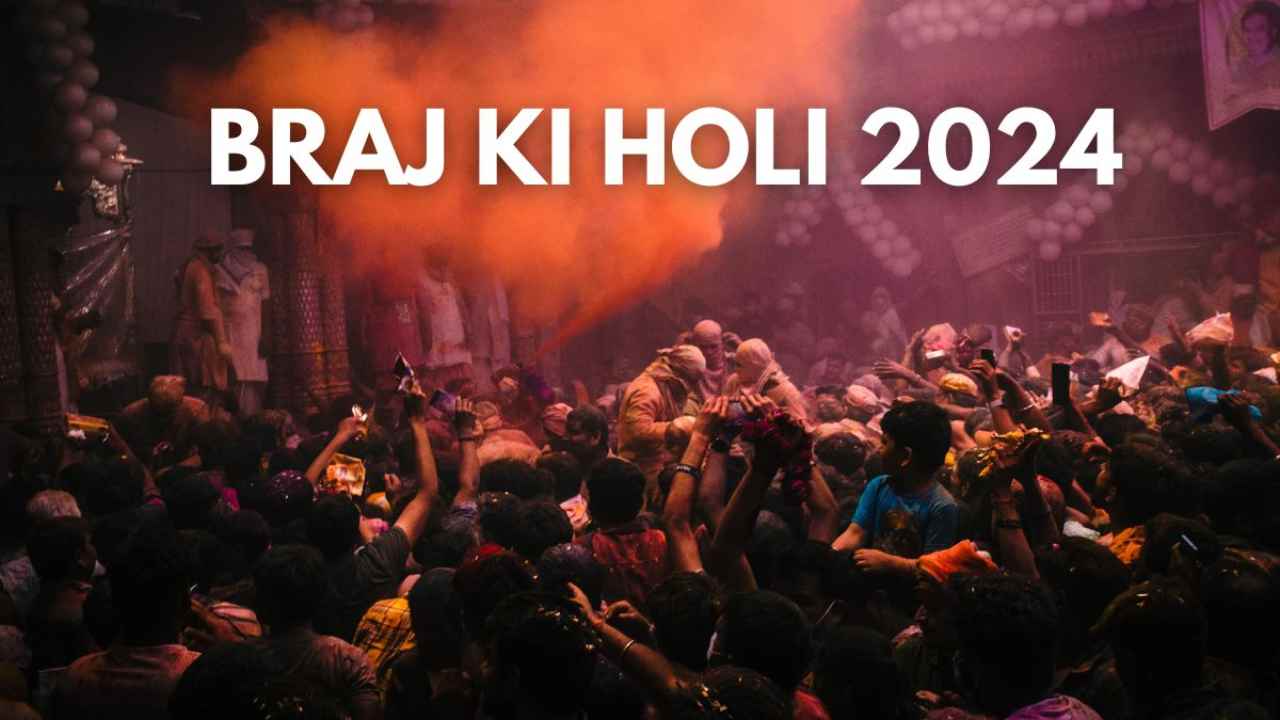Holi is celebrated in diverse ways with a range of traditions in different parts of the country. The 10-day Braj Ki Holi celebrations, that begin prior to the main Holi festivities stand out with its unique, creative and vibrant rituals.
As the name suggests, the Braj Ki Holi traditions take cue from Lord Krishna and Radha’s life and the celebrations at Mathura, Vrindavan, Barsana, Nandgaon, Gokul are dedicated to Krishna Kanhaniya, who spent his childhood in these regions.
Braj Ki Holi Dates

Starting from Basant Panchami, Braj region is in celebration mode for almost 40 days with festivals and fasts like Phulera Dooj, Holi and Rang Panchami observed during the period. Braj Ki Holi is being celebrated from March 17 to March 26, starting almost 10 days before the main festival and extending a day after it.
History Of Braj Ki Holi
Lord Krishna believed to be a mischievous child, played pranks with colours on Gopis of Vrindavan, hence initiating the tradition of playing Holi with colours. The legend goes that Lord Krishna used to rue about his dark complexion to Maiyya Yashoda asking why Radha was so fair and beautiful, while he was not.
Yashoda laughed and asked him to colour Radha’s face to match his complexion. He took his mother’s playful suggestion seriously and actually smeared Radha’s face with colour and this led to the beginning of Braj Ki Holi celebrations
Braj Ki Holi Calendar
March 17: Laddu Holi at Radha Rani Temple, Barsana

During Laddoo Holi celebrated in Barsana women playfully hurl laddoos at men, symbolising the playful teasing of Lord Krishna by the gopis.
March 18: Lathmar Holi at Radha Rani Temple, Barsana
Barsana’s Lathmar Holi symbolises Radha and Gopis beating Lord Krishna with sticks when he smeared colour on them. Celebrated a few days prior to main Holi, men from neighbouring towns, especially Mathura.
March 19: Lathmar Holi at Nandgaon
Similar tradition is observed in Nandgaon during Lathmar Holi when men from Barsana visit the town to playfully tease the women with sticks (lathis). Women, representing the Gopis, respond by chasing them away with sticks, symbolizing the playful interaction between Lord Krishna and the Gopis during Holi.
March 20: Phoolwali Holi at Banke Bihari Temple, Vrindavan

In Phoolwali Holi, the legend of Lord Krishna and Radha playing with flowers is recreated. Devotees gather at the Banke Bihari Temple of Vrindavan where priest representing Lord Krishna showers colourful flowers on the devotees.
March 21: Chhadi Mar Holi in Gokul
Celebrated in Gokul which is around 15 km away from Mathura, this is a similar tradition to Lathmar Holi. In place of large laths, small sticks are used by women to playfully beat men.
March 23: Widow’s Holi at Radha Gopinath Temple, Vrindavan
Widows staying in Vrindavan ashrams await this day to participate in this vibrant celebration where they smear each other with colours. These women, who have lost their husbands, often lead a life deprived of many joys and celebrations, but on this day, they come together and immerse themselves in the colours of Holi festivities.
March 24: Holika Dahan and Holi of flowers at Banke Bihari Temple
On this day, in the Braj region, people celebrate Holika Dahan or Chhoti Holi in a traditional way by lighting a bonfire and celebrating victory of Prahlad over Holika and the triumph of good over evil.
March 25: Holi in Mathura and Vrindavan

Colours or Gulal made of natural substances like flowers and kesar are sprinkled on people by priests of temple of these places. People come from across the country for this celebration.
March 26: Huranga Holi in Baldev at Dauji Temple
Men and women play the traditional Huranga game the day after Holi at the Dauji temple near Mathura. During the annual festival, men pour buckets of colour on women while the women tear off their shirts.
Braj region be it Mathura, Vrindavan, Barsana, or Nandgaon holds a great significance in Hindu mythology as these places are associated with the life of Lord Krishna, an avatar of Lord Vishnu. The region has many temples and pilgrimage sites and is visited frequently by devotees of Lord Krishna.



